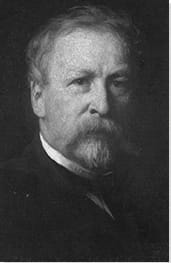Summary of Jonathan Eastman Johnson
Johnson ranks amongst America's foremost genre and portrait painters. He possessed supreme technical and compositional skills which he used to chronicle events, and to represent individuals, in an era of great social and political upheaval. Johnson was a liberal minded man (a Unionist) whose art addressed the civil war, the abolition of slavery, and scenes of simple rural life in New England. Johnson's portraits, meanwhile, ranged from street urchins, to war widows, to financiers, to Presidents. He was also an active board member on progressive arts institutions, including New York's Metropolitan Museum of Art, which he co-founded, and which displays his name above its entrance.
Accomplishments
- Johnson's reputation was confirmed with a signature painting, Negro Life in the South (1859). One of the most important paintings in 19th century American art, Johnson presented the American public with an intricate "plantation narrative" (it was, in reality, set in the yard of a Washington D.C. tenement) of African American slaves enjoying some "downtime". What was remarkable about the painting was a level of ambiguity that prompted widespread public debate. Apologists read the work as evidence of the "easy living" and community cohesion of life in servitude, while abolitionists saw the dilapidated living conditions and tatty clothing of the protagonists as symbolic of the injustices of racial oppression.
- Johnson, a committed Unionist, was a chronicler of the American Civil War (1861-65). However, his war paintings differed from his European counterparts in that he veered away from images of individual heroism and national triumphalism. His take on conflict focused rather on the impact of war away from the battlefields (such as the images of anxious children and wives). One of his best-known works, Ride For Liberty (1862), retold an event he had witnessed first-hand in which a young African American family took their fate into their own hands by using the backdrop of chaos of the conflict to plot their escape on horseback across union lines into the free North.
- Through his images of land workers plying their traditional trades (like corn husking and maple and cranberry harvesting) in New England, Johnson was honouring the simple lives of the ordinary peasant worker. With echoes of the styles of 17th century Dutch and Flemish masters, and 19th century Realists such as Jean-François Millet, he helped transform this everyday subject matter into fine art. Through these works, moreover, Johnson brought about a greater national awareness of the traditional/universal values of the humble New England way of life.
- In the last years of his career Johnson turned almost exclusively to portraiture. His mature portraits were wide ranging in their choice of subject. He represented the lives of everyday Americans in titles such as Feather Duster Boy (1880) and Old Man Seated (1880-85), while at the same time completing prestige commissions for prominent public figures including Presidents, Grover Cleveland (1891) and Benjamin Harrison (1895).
The Life of Jonathan Eastman Johnson
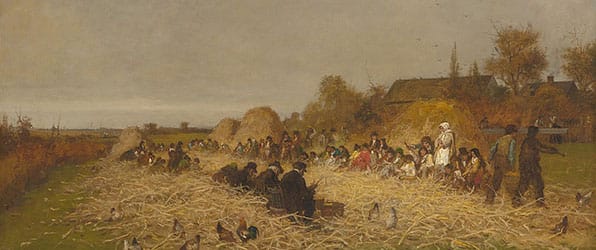
The National Academy of Design writes, "Today, Johnson is recognized as a painter who brought more sophisticated painting techniques to America, and extended the range of 'American' subjects, often transforming traditional European themes, bringing a more dignified and democratic content to genre painting. He spoke to and for his own generation."
Important Art by Jonathan Eastman Johnson
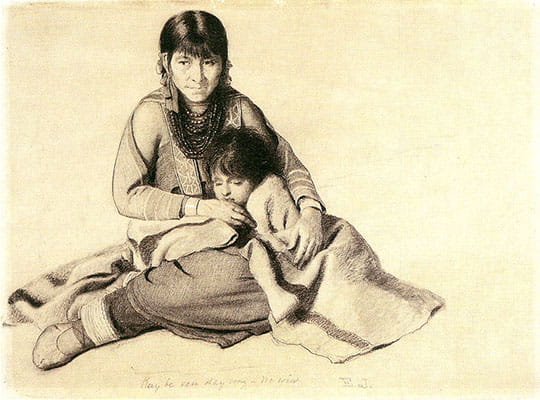
Ka be sen day way- We win
In this charcoal portrait, a young Ojibwe mother sits on the ground with her legs curled beneath her. Her arms are wrapped around the shoulders of her child, who is wed up in a blanket, with its head against the mother's chest. In the 1850s, Johnson used his skills as a portrait artist (something he had done almost exclusively for wealthy and powerful clientele up to this point) to produce several sketches and paintings of the Ojibwe people living close to Lake Superior. Thanks to the help of his part-Ojibwe-part-African-American guide, Johnson managed to develop a strong rapport with the members of these communities, who allowed him to observe them as they engaged in their everyday activities.
Curator Peter Spooner remarks that Johnson's portrayals of the Ojibwe people "have all the fullness and the character of the real human in a real setting. But they also have an intimacy, and a casualness". Though he was not the only artist focusing on the lives of Native Americans at the time, his work reflects his close connection with the communities. He often included the names of the sitters in his titles, which was highly uncommon (and respectful). Contemporary Ojibwe artist Carl Gawboy notes that Johnson represented his Ojibwe sitters with a high degree of accuracy, "I can go to Indian communities today and I see those same faces. They are our real ancestral portraits because we can still see those faces today". Sadly, Johnson's sketches and paintings of the Ojibwe were not popular during his lifetime and did not sell.
Charcoal on paper - St. Louis County Historical Society, Duluth, Minnesota
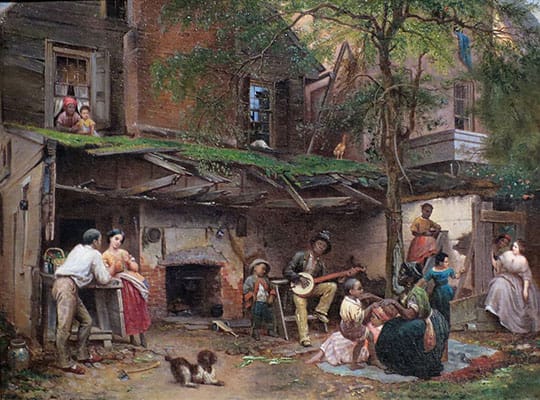
Negro Life at the South (Old Kentucky Home)
In this painting, Johnson depicts a joyful scene of African-American slaves in the backyard of a dilapidated house, which served as slave quarters, at F and 13th streets near Johnson's father's house in Washington D.C. Just to the right of center, an elderly man plays a banjo, as a young boy looks on. In front of them a woman and child dance on a blanket on the ground on which another young girl sits. To the left of the center, a small brown and white dog adopts a playful pose as if it is about to join in with the singing and dancing. At the far left, a young black man leans against a table, flirting with a lighter-skinned young woman. Above them, an elderly woman and a toddler watch the entire scene through a second-floor window. At the far right, we see a section of a house in much better condition. Two young females, one white in an elegant gown, and behind her, one African-American, have apparently just stepped outside to peek at the main group of figures. Art historian John Davis writes that the white woman "has entered an unusual and particular space [...] she has crossed into the 'secret city' of black life". She provides a point of access into the image for white viewers.
This work, widely considered Johnson's masterpiece, was exhibited in 1859 (two years before the start of the Civil War) at the National Academy of Design. It was well-received by both slave owners and abolitionists. As Davis writes, it implied for the former group that "forced servitude was neither physically onerous nor destructive of family life", while the latter group "saw the painting as documentation of the squalid living conditions of slaves". When the painting was exhibited, one reviewer wrote that "It is conscientiously studied and painted, and full of ideas. Notwithstanding the general ugliness of the forms and objects, we recognize that its sentiment is one of beauty, for imitation and expression are vitalized by conveying to our mind the enjoyment of human beings in new and vivid aspects."
Of further interest is the fact that Johnson portrayed slaves with a wide range of skin tones, which could have been his subtle way of inviting the viewer to consider the mixed racial ancestry of the slaves. Even the dog is both brown and white. Other elements in the image hint at the existence of a wealthier white father, such as the ladder that runs from the base of the dilapidated house up to the roof of the "better" house next door, and the presence of a hen on the roof of the slave house and a rooster on the other house.
Oil on linen - High Museum of Art, Atlanta, Georgia
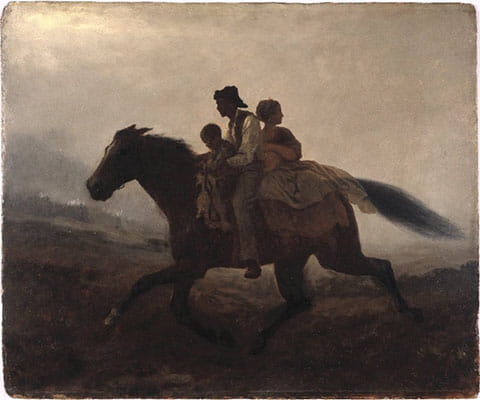
A Ride for Liberty - The Fugitive Slaves
In this painting, which was created during the early days of the Civil War, an African-American family (father, mother, child, and baby) are shown on horseback galloping across a field at dawn. According to Johnson (noted by him in an inscription on the back of the painting), this work was based on a scene he witnessed on March 23, 1862, as he accompanied Union General George B. McClellan's troops advancing toward Manassas, Virginia. As historians Scott Mestan and Dr. Bryan Zygmont describe, with "A Ride to Liberty, Johnson recreates an event commonly seen during the American Civil War, that of slaves crossing battlefields from the Confederate South to the Union North in order to escape the horrors of their bondage [...] The horse gallops from right to left across the nearly barren battlefield. Each family member looks in a different direction. The father, ahead to the promise of the future, the wife looks back to the hardships of the past, while the child stares downwards at the excitement of the present".
Complicating the idea that Abraham Lincoln's government was wholly responsible for freeing slaves, this radical painting presents the idea that slaves played an active role in their own emancipation. Art historian Donna Thompson Ray asserts that "Although the painting offers a somewhat romantic view of slave resistance, using dusty colors and active brushstrokes, it also presents a departure from the more commonly known contemporary illustrations of African Americans as shiftless, childlike, or bestial. The painting portrays a slave family in a dignified manner, providing little detail in facial expression or indication of plantation-life status. A Ride for Liberty highlights the courage of individual slaves in pursuing the hopes and dreams of a fair and just society".
Mestan and Zygmont pick up on the interesting detail concerning the horse. They write: "During the time period surrounding the Civil War, horses were often characterized by the number of 'white socks' they had. It was then believed that the fewer the number of white socks, the greater a horse's value. Indeed, during the middle of the nineteenth century horse traders believed there was a direct relationship between the amount of white on a horse's lower limbs and its stamina. Thus, a horse having only one - or more preferably, none at all - white sock would increase its potential value. When applying this to Johnson's painting, we can observe that the horse the soon-to-be-free slaves ride has only one white sock, and it is a small one at that. This indicates - for the nineteenth-century viewer, at least - that the horse has been stolen in this noble cause was both valuable and of good breeding".
Oil on paperboard - The Brooklyn Museum, New York
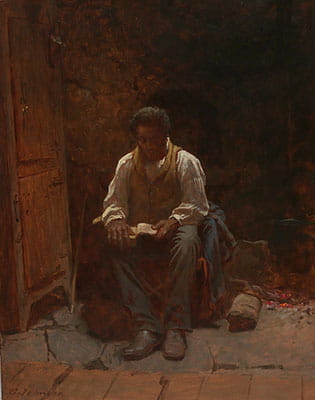
The Lord is My Shepherd
In this painting, created just months after the announcement of the Emancipation Proclamation, an African-American man sits in a dark, barren room, next to a kitchen hearth on a folding stool with a canvas seat. He is reading a book (presumably the Bible, based on the title of the work which comes from Psalm chapter 23). Resting on the seat lays a blue jacket, which likely indicates that he served in the Union army. It was not uncommon for Johnson to depict African-Americans who played an active role in pursuing liberation for themselves and their fellow slaves. The act of reading depicted here is also significant, as literacy (which was illegal for slaves in the South) was considered an important step toward achieving freedom.
Curator Eleanor Jones Harvey notes that this work addressed both black and white audiences. She writes that "A black person reading the Bible affirmed blacks' capacity for understanding Christian Scripture, of finding in it messages of hope and faith. For whites, many of whom had limited direct contact with blacks, it reassured them that, in freeing enslaved people, they were encouraging an influx of Christian believers who would become part of American society with minimal disruption to those norms. It was comforting to whites to think of formerly enslaved people not as angry and vengeful, but as forgiving New Testament believers".
However, Harvey also recognizes certain details that indicate a more complex story. She explains that "The title conjures the comforting words of the Psalms. But the Bible is not open to Psalms, which is in the middle of the book, but to the front - to Exodus - with its much more compelling message: 'Let my people go.' Exodus runs like a river through stories of escape from slavery. The parallels were easy to draw between plantation overseers and the pharaoh, and between their strongest opponents - Sojourner Truth, Harriet Tubman, Frederick Douglass - and Moses, who served as a shepherd to his people as he led them out of Egypt to the Promised Land". It is perhaps his controversial take on what was the most hotly debated topic of the time (the Emancipation Proclamation) that Johnson never exhibited the painting publicly.
Oil on wood - Smithsonian American Art Museum

Sugaring Off
Johnson produced several sketches, and about twenty-five paintings, about the New England maple sugar camp, the most famous of which is Sugaring Off. The scene takes place in a forest clearing, with areas of thawing snow visible on the ground. Occupying the foreground is a large group of people engaged in various stages of the maple syrup production process, including a group of men standing around a cauldron above a fire at the center of the images, in which the sap is boiling. As art historian Katherine E. Manthorne explains, by 1860, Johnson "seems to have reached a decisive moment in his career, and began to reclaim his New England identity, both in his art and in his life. That summer he returned to his native Fryeburg Maine, as he did for much of the decade, where he would find the rural subjects for which he became justly renowned. He first tried his hand at a corn husking scene, but when he returned in the fall of 1861 it was with the aim of painting a maple sugar camp".
Throughout the scene, men, women, and children are pictured working, socializing, and playing. Art critic Brian T. Allen explains that "Johnson invested more time and effort into this epic project than any other in his career. Working in a specially-constructed studio built on wheels, he spent every spring for five years recording the activities at the sugar camps in Fryeburg". Allen points out that Johnson's scenes of maple sugar camps served as much more than just nostalgic representations of an important aspect of local heritage. Rather, they "were intended to communicate a powerful message about freedom and independence," as well as about the resourcefulness and strong work ethic of rural Americans. Says Allen, "It has been estimated that about two-thirds of the twenty million slaves taken from Africa to America labored to produce cane sugar, which was exported to Europe and later sold in urban American markets. A strong supporter of the Union cause, Johnson identified maple sugar, created by free people in their own community, as a valuable alternative to cane sugar produced by slaves. Similarly, the sugaring off served as an example of communally-based work in harmony with nature and as a symbol of unity in a country divided by war".
Oil on canvas - De Young Museum, San Francisco, California
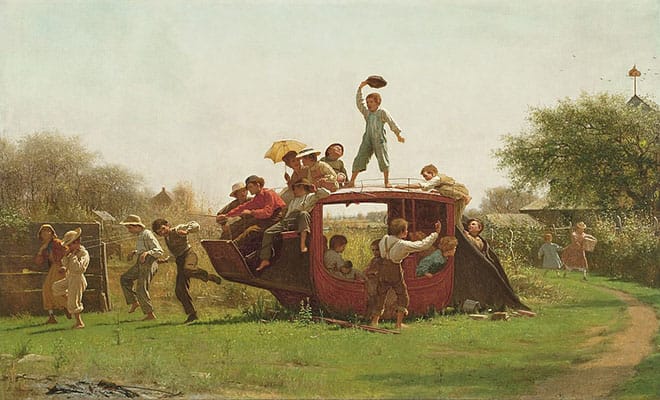
The Old Stagecoach
The Old Stagecoach is considered Johnson's second great masterpiece (after Negro Life at the South (Old Kentucky Home) (1859)). The work helped to revive Johnson's career at a point when his popularity was on the wane. The scene takes place on and around an abandoned stagecoach in the countryside. A large group of carefree children play on and around the discarded vehicle, pretending to be passengers, drivers, and even horses. The children are presumably pupils at the red schoolhouse visible in the background on the right-hand side of the painting (their bags and lunch boxes lay strewn about in the grass). Johnson painted the work in his Nantucket studio, recruiting local schoolchildren to model for him. The stagecoach was inspired by one he had come across and sketched while hiking in the Catskills. Taken as a whole, the painting can be read as a commentary on America's post-civil war Reconstruction Era, with the broken-down stagecoach representing the damaged nation, and the jubilant children symbolizing hope for a better, happier future.
The theme of childhood innocence was popular at the time. During the 1800s, the general attitude in the United States shifted, and children were seen as the country's future. Children were encouraged to play and have fun, as opposed to contributing to family life through work and chores (as had been customary previously). Johnson captured this sentiment perfectly, depicting children whose collective imagination has all but resuscitated the ruined vehicle.
Several interesting details emerge from this scene. One girl rides atop the stagecoach and carries a parasol, as though emulating a grown-up woman (as children love to do). Meanwhile, an African-American girl who pretends to be a horse appears to be choking on the reins around her neck. Johnson was deeply concerned with race relations, and it is probable that this vignette was intended to reference the shame of lynching in the United States. The stagecoach's name, Mayflower, is also certainly significant, referencing the ship that brought the pilgrims from England to America. Perhaps Johnson is encouraging the viewer to consider whether the goals and ideals of these original settlers had actually been realized throughout the nation's history.
Oil on canvas - Milwaukee Art Museum
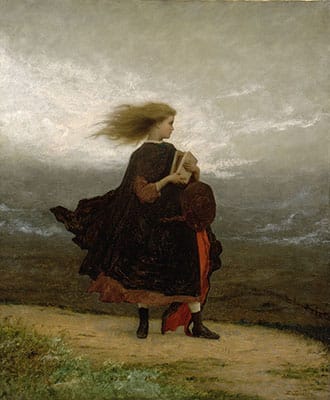
The Girl I Left Behind Me
In this American civil war painting, a young married woman (the wedding band on her left hand confirms this important narrative detail) in a fine smock and red dress stands in blustery winds on a coastal hilltop. The angry grey skies and choppy ocean waves meet at the horizon while in the near distance we see a split-rail fence. Our heroine looks off into the distance to the right, her blonde hair blowing in the wind, and she clutches two books to her chest. He facial expression suggests that she has something on her mind.
The Girl I Left Behind Me is a subtle commentary of the United States following the Civil War (which had ended seven years before the painting was completed). The woman is symbolic of a nation uncertain of what lies ahead; she may bravely traverse the untrodden trail in front of her, or, she could return the way she came. The wedding ring indicates that she is awaiting the return of her husband from war but it may also symbolize fidelity to the nation. The fence in the background may hint at the idea of a nation divided (given that title of the work comes from an Irish ballad that was popular with soldiers on both sides of the Civil War). The painting exemplifies the way in which American art of the Civil War had (or could) distinguish itself from typical European history painting which tended to glorify the deeds of war heroes. Here, Johnson (who was trained in Europe) presents a more nuanced view of war and its consequences for all of society.
Oil on canvas - Smithsonian American Art Museum, Washington D.C.
Biography of Jonathan Eastman Johnson
Early Life
Jonathan Eastman Johnson (or simply Eastman Johnston as he is known) was the youngest of eight children born to Philip Carrigan Johnson and Mary Kimball Chandler. He was born in Lovell, Maine, moving to the nearby town of Fryeburg soon thereafter. The family then moved partway across the state to the capital city of Augusta, in 1836. Johnson's father owned several businesses and was active in local fraternal organizations and politics. He served as the Grand Secretary of the Grand Lodge of Maine (ancient Free and Accepted Masons) from 1836-44, and in 1840 was appointed Secretary of State for Maine (a role he served in for two years).
When he was fifteen, Johnson left home to work in a dry-goods store in New Hampshire before joining the Boston lithography shop of J. H. Bufford, where he designed title pages for books and sheet music. At the age of eighteen, he returned to Augusta and opening his own crayon-portrait studio. Two years later, he moved to Washington, D.C., where his father had accepted an important clerkship in the Navy Department.
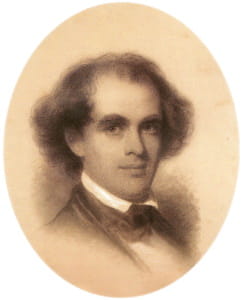
In 1846, having spent just one year in Washington, Johnson returned to Boston at the invitation of poet Henry Wadsworth Longfellow who commissioned portraits of himself and his family and friends. (He had painted his first oil portrait - of his grandmother - in 1848) He remained in Boston until 1849, maintaining studios in Amory Hall and Tremont Temple, and drawing crayon portraits of notable figures including the writer and abolitionist Ralph Waldo Emerson, author Nathaniel Hawthorne, and senator Charles Sumner.
In 1853, the family lived in a new rowhouse at 266 F Street, close to the White House and Navy Department Offices. Johnson's father's political connections helped him gain portrait commissions from prominent figures including the former first lady Dolly Madison, lawyer and statesman Daniel Webster, and former president John Quincy Adams. These early portraits were executed in simple black crayon.
Education and Early Training
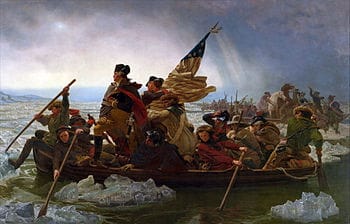
In 1849, Johnson traveled to Germany where he studied at the newly founded Kunstakademie in Düsseldorf for two years. At the academy, he received rigorous training in drawing, with a focus on anatomical accuracy. In 1850 he submitted two paintings to the American Art-Union in New York, before, in January 1851, entering the studio of German-American history painter Emanuel Gottlieb Leutze (the creator of Washington Crossing the Delaware (1851)). Johnson wrote to the American Art-Union "I have now recently gone with Mr. Leutze and am painting under his instruction in an immense atelier which he rented for his big picture [Washington Crossing the Delaware], with others beside himself, excellent artists, and both engaged on large works, forming an atmosphere and an aspect of art not less delightful than it is improving, and I regret now that I had not been with him during my entire stay in Düsseldorf".
In the summer of 1852, Johnson travelled to London to visit the Universal Exposition, and from there, to The Hague, where he remained for three and a half years, studying the art of 17th-century Dutch and Flemish masters. While in The Hague, Johnson received several commissions through the wealthy American ambassador August Belmont. He became known in fact as the "American Rembrandt" and was offered a position of court painter, which he turned down. He then relocated to Paris where he worked for a brief spell in the studio of French history painter Thomas Couture before he was obliged to return to the United States in October of 1855 following the death of his mother.
In 1856, Johnson travelled to Lake Superior to visit his sister and brother-in-law. Whilst there, he gained access to Chippewa and Anishinaabe (Ojibwe) tribes whose members he sketched and painted. His guide/interpreter was Stephen Bonga, who was part Ojibwe and part African-American (and was himself the son of a freed slave). Contemporary Ojibwe artist Carl Gawboy believes that Johnson's relationship with Bonga had a significant influence on his painting, not just in terms of gaining access to tribe members, but also with regard to his attitude towards indigenous and African Americans.
Says Gawboy, "Where else would a New Englander ever meet an African American on such intimate terms? And when he went back out east and the abolitionist movement was just starting, he saw something that was really important that he wanted to be a part of -- the humanity of black people. Just as he was able to capture the humanity of Ojibwe people in this part of the country." And speaking of Johnson's paintings of the Ojibwe, Gawboy added, "obviously these Indians are relaxed, and that's a real important part of his paintings. They aren't formal, stiff portraits -- as happened with many photographers at a later time".
The next two or three years saw Johnson move between Cincinnati, New York (where he opened a studio in the New York University Building), and the family home in Washington, D.C. His major career turning point came in 1859 when his painting, Negro Life in the South (1859), was exhibited to great acclaim, from both abolitionists and slave traders, at New York's National Academy of Design. By prompting political and public debate, the painting's impact reverberated outside the art world too. Indeed, it led directly to Johnson being elected as an Associate to the National Academy of Design (he became a full Academician the following year) and, in 1860, a member of the Union League Club of New York.
Mature Period
During the American Civil War (1861-65), Johnson followed the Union Army and sketched subjects he later developed into genre paintings, such a Wounded Drummer Boy (1862-72) and Writing to Father (1863) which shows a young boy, deep in concentration, writing to his absent father whose army cap rests on a chair next to the boy sits. He also continued to address head on the topic of slavery through works such as Ride for Liberty (1862) in which a young African American family are shown taking their right to freedom into their own hands.
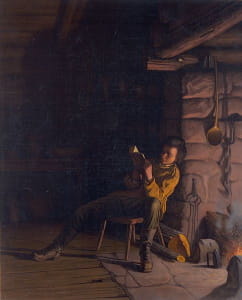
He also paid his own homage to the recently passed Abraham Lincoln. The University of Michigan Library says of the portrait, "Johnson shows Abraham Lincoln as a young boy seated before a glowing fire reading a book in a dark rustic interior setting. Painted just three years after Lincoln's assassination, this intimate genre scene reflects widely-held conceptions of Lincoln's commonness and modest upbringing while emphasizing his humanity and high moral character through the virtue of his dedication to hard work and to his intense commitment to learning".
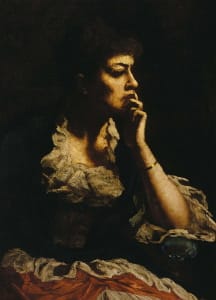
In 1869 Johnson, now aged 55, married Elizabeth Buckley. Two years later, he built a summer home for the couple in Nantucket, where he also established a second studio. By now Johnson had become the most famous genre painter in the country. The art critic Russell Sturges, Jr. wrote that "A collection of Mr. Johnson's pictures would probably be more interesting to visit than one of any other American painter. His work, taken together, is more truly representative of his countrymen. [...] There is no painter, not even among the younger men who are just coming into sight from behind the horizon, who get on faster, or who leave the past of a year or two back more decidedly and forever behind".
Late Period
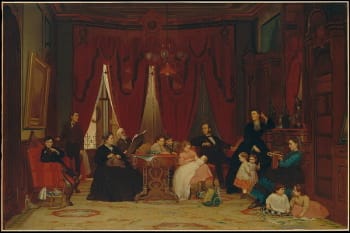
By 1870, Johnson had helped co-found the Metropolitan Museum of Art in New York (his name is inscribed above its entrance). Also in that year, he and Elizabeth had their only child, a daughter, Ethel Eastman Johnson (who later married Alfred Ronalds Conkling, the nephew of Senator Roscoe Conkling). The Johnsons were by now very wealthy, owning a large home in Manhattan, in addition to their summer home in Nantucket. Indeed, Johnson's reputation was such that he could command high fees for society portraits. One of the first was for the prominent Wall Street broker Alfrederick Smith Hatch. He, like others in his social circle, became a keen collector of art and commissioned Johnson to paint a group portrait showing three generations of his family (Hatch himself is seated to the right at his desk). Signifying the family's cultural sophistication and its wealth, the painting took pride-of-place in the Hatch library at their residence at 49 Park Avenue.
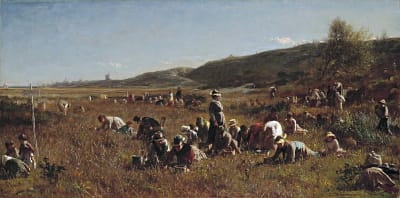
In the decades immediately following the war, Johnson sketched and painted the people of New England at work engaged in leisure pastimes and work activities. Of the latter, the Smithsonian Museum writes, "His paintings of [Nantucket] island cranberry harvests and maple sugar gathering in Maine transformed these familiar scenes into fine and popular art, creating a national awareness of extant but vanishing rural life in these New England places. The popularity of Johnson's scenes of rural labor in New England marks them as part of the widespread impulse to assign values identified with New England - independence, resourcefulness, devotion to hard work - to the entire nation".
In the final decades of his life, Johnson continued to paint and exhibit widely, but forward of 1880 he focused almost exclusively on portraiture. He continued to receive prestigious commissions from politicians and bankers, but he complemented these with many portraits of ordinary American people in their natural surroundings. Johnson also continued to be active in the National Academy, the Century and Union League Clubs, the Metropolitan Museum, and the Society of American Artists. In 1885 and 1897, Johnson made his final trips to Europe. He painted very little after 1900. In 1906, Johnson passed away at the age of eighty-one. He was buried at Green-Wood Cemetery in Brooklyn, New York.
The Legacy of Jonathan Eastman Johnson
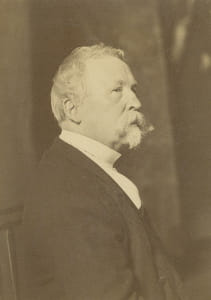
Johnson was a pioneer in nineteenth century American genre painting. One of the first American artists to have studied in Europe, he brought the skills and techniques back to the United States which he adapted to create a distinctly American style. Like other American artists of the Civil War era (such as Winslow Homer), Johnson's images of the conflict and its aftermath did not glorify battle (as they did in European history painting) but rather sought to present the realities of the conflict and its psychological effect on the nation. His art influenced American realists and Social Realists, like Raphael Soyer, and later still, many of the artists of the Works Progress Administration. Moreover, Johnson's focus on representing racial minorities and the working classes influenced Ashcan School artists like Robert Henri and George Bellows, while his Romantic approach to landscapes also influenced the Hudson River School artists.
Not only were Johnson's paintings of great technical merit, they captured on canvas one of the most important transitional periods in American history. He portrayed African-Americans (as both slaves and free men) as noble and as active participants in their own fight for liberation. Similarly, his representations of Native Americans (mainly Ojibwe) were remarkable for their sense of intimacy and authenticity. And Johnson furthered the cause of the arts in America as one of the founders of New York's famous Metropolitan Museum of Art. Although in later life he earned much of his income as a society portrait painter, it is Johnson's work as a painter of everyday people and everyday life that remains most significant.
Influences and Connections

-
![Rembrandt van Rijn]() Rembrandt van Rijn
Rembrandt van Rijn -
![Jean-François Millet]() Jean-François Millet
Jean-François Millet ![Thomas Couture]() Thomas Couture
Thomas Couture- Emanuel Gottlieb Leutze
-
![Winslow Homer]() Winslow Homer
Winslow Homer ![Henry Wadsworth Longfellow]() Henry Wadsworth Longfellow
Henry Wadsworth Longfellow- Jervis McEntee
- Thomas Waterman Wood
- J. G. Brown
- Thomas Hovenden
- George C. Lambdin
-
![Winslow Homer]() Winslow Homer
Winslow Homer ![Henry Wadsworth Longfellow]() Henry Wadsworth Longfellow
Henry Wadsworth Longfellow- Jervis McEntee
Useful Resources on Jonathan Eastman Johnson
- The Civil War and American ArtBy Eleanor Jones Harvey
- Eastman Johnson: Painting AmericaOur PickBy Teresa A. Carbone and Patricia Hills
- Eastman Johnson: The Cranberry Harvest, Island of NantucketBy Marc Simpson, Sally Mills, and Patricia Hills
- Sugaring Off: The Maple Sugar Paintings of Eastman JohnsonBy Brian Allen
- Eastman Johnson's Lake Superior IndiansBy Patricia Condon Johnston
- Eastman Johnson 1824-1906By John Baur
- Eastman Johnson: Collector's Edition Art GalleryBy Nancy Davis
 Ask The Art Story AI
Ask The Art Story AI